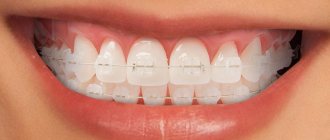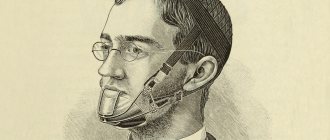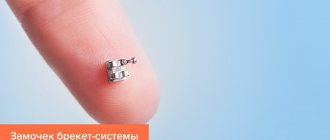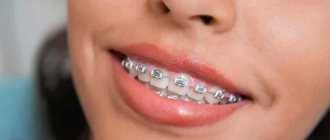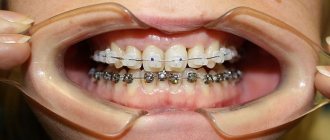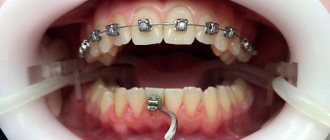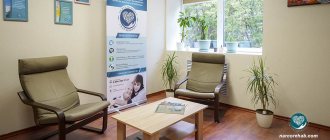Can I get braces at 30 or 40? This question is often asked to dentists by adult patients who have long dreamed of an attractive Hollywood smile. Thanks to innovative technologies, teeth straightening and bite correction today have no age restrictions. Modern fixed appliances allow the formation of an even dentition for both children and adults. It’s just that the same braces at different ages will solve different problems. Let's figure out together how exactly therapy for children and adolescents differs from the treatment prescribed to their mothers and fathers.
People around you start to envy you kindly
Not many people can boast of a perfect smile, but only a few take on this problem. However, braces on an adult are causing others to think about going to the dentist again. Yes, people around you will pay attention to you more often; friends and acquaintances will begin to be interested in the details of the treatment, the sensations, and the cost of the design. One thing is for sure - they will respect you, because you care about your health and did what many do not dare to do. In addition, not everyone is ready to shell out more than 100 thousand rubles to correct their smile.
Braces Options for Adult Patients
After the age of 30, you can use ligature and non-ligature devices made of ceramic, metal or artificial crystal (sapphire). When choosing a design, the doctor is guided by the severity of the problem, requirements for aesthetics, functionality and budget.
Ligature-free braces are classic, but with improved fixation. The design does not have rubber or wire ligatures and looks neater in appearance. For fixation, specially designed locks with caps or clips are used. There is no rigid fastening, that is, the arc slides in the grooves. The correction is gentle, the patient does not experience discomfort, pain or long-term adaptation. The movement of units to the calculated position occurs without load, which allows you to lead a normal lifestyle without major adjustments to your diet. The design works on the principle of stimulating the muscle frame around the teeth, which provides the following benefits:
- the duration of therapy is reduced;
- the number of doctor visits for monitoring and adjustment is less than when using standard systems;
- hygiene is facilitated;
- The treatment is comfortable, there is no pain when tightening the arch;
- there are no injuries to the mucous membrane or gum tissue;
- The aesthetics of the device are higher.
The only downside is the increased cost. In addition, such devices are not installed in all clinics, since the doctor must have certain experience.
Lingual braces are placed on the back of the teeth and are not visible from the outside. The advantages of this method of therapy include:
- the period of adaptation is short;
- pathologies of almost any level of complexity can be eliminated;
- changes in the treatment regimen are allowed;
- 3D modeling technology is used for manufacturing to increase the accuracy and reliability of the installation;
- when talking or eating, the elements of the device are not visible to others;
- the risks of enamel damage by caries are reduced.
Flaws:
- The installation procedure is complex and takes more time;
- the first days after fixation, the patient experiences discomfort and may touch the locks and arches with his tongue;
- hygiene on the inside of the row requires increased attention;
- installation is lengthy.
Various materials are used for manufacturing, among which the most popular are ceramics and sapphire. Such devices are hardly noticeable on the teeth, but they are used for pathologies of moderate and minor severity. If the anomaly is serious, the doctor chooses classic metal structures.
Reaching a new goal
Perhaps you are faced with a difficult choice: on the one hand, you are embarrassed about your smile, on the other, you do not want to wear braces for 1 to 3 years. But the faster you start, the faster you finish. As they say, the best time to do this is yesterday, the second best time is today. Moreover, you will experience great joy as you systematically move towards your goal, seeing how your teeth are straightened month after month, and in the end you will get the long-awaited result - a beautiful smile. This experience will certainly be useful in other areas of life.
An alternative to braces is aligners.
In many cases, aligners can be used instead of inconvenient braces. Their key feature is that it is a removable structure made of transparent plastic that fits tightly to the teeth. This option is indispensable for those who, for some reason, cannot allow their appearance to change, because braces are clearly visible when talking and smiling, and they will have to be worn for several months, sometimes even up to 2 years. Of course, there are braces that are less noticeable, made of polymer or ceramic materials, as well as lingual braces, which are placed not on the outside, but on the inside of the dentition, but they cannot always be used, and their cost is much higher than usual.
Aligners are an analogue of braces, since they use the same general principle - applying constant pressure to the teeth in order to move them in the desired direction. The only difference is in the design, and as a result, in some functions and properties. Firstly, they are transparent, which makes them very unnoticeable from the outside, and secondly, they can generally be removed during an important meeting or photo shoot. To achieve the desired effect, aligners must be worn 20-22 hours a day, so you can always find time for meals or negotiations to remove the aligners for a while.
The difference between aligners and braces includes several important points:
- aesthetic – unlike braces, they are not visible,
- mechanics of impact – more evenly distributes pressure on each tooth,
- removable - they can be removed, hence there are fewer restrictions on food intake and easier hygiene,
- allergenicity - are made of hypoallergenic plastic, and braces are made of metal.
An orthodontist will help you decide to use aligners or braces in case of dental alignment, based on the specific clinical situation, individual characteristics and requirements of the patient.
Cons and contraindications
We have already partially written about the disadvantages of brace systems above. All of them are not so significant as to make you doubt whether to put braces on your jaw. The main ones include possible damage to the enamel, complicated oral care, time and cost of treatment.
In what cases can orthodontic treatment not be carried out? There are not many absolute contraindications: epilepsy, tuberculosis, HIV, developmental features. The rest are relative: the presence of untreated teeth and inflammatory processes in the oral cavity, severe tooth wear, some diseases of the cardiovascular system, exceptional cases. The dentist will be able to accurately answer whether the bite needs to be corrected in your situation after examination and diagnosis.
Start of orthodontic treatment and dental hygiene
And now, about the dangers of long-term orthodontic treatment with braces. Undoubtedly, during the period of orthodontic treatment, individual hygiene deteriorates. Which entails many negative consequences: caries, pulpitis, periodontitis, etc. Therefore, in addition to your own hygiene, your doctor is obliged to carry out professional hygiene, stone removal, Air Flow, cleaning of periodontal pockets, cleaning of the proximal surfaces of teeth with special instruments. There are also indicator tablets that identify particularly difficult to clean and hard-to-reach areas. I recommend orthodontic kits with brushes, brushes, dental floss and indicator tablets to my patients. If somewhere, something is not cleaned, we carefully remove it using professional hygiene, polish it and continue to monitor individual hygiene so that there are no prerequisites for caries, age spots and other troubles associated with poor hygiene. It is the orthodontist’s responsibility to teach proper hygiene when correcting a bite with braces, and the patient must follow the doctor’s recommendations with all seriousness and diligence. Otherwise, a meeting with related specialists and a drilling machine cannot be avoided.
If you wear braces for a long time
(Clinical case)
A 25-year-old girl asked for help. Four years ago, I got braces installed. Due to life circumstances, I stopped treatment, but did not remove the braces. Suffers from dental phobia. Extremely poor oral hygiene. Premedication was given: 1/2 relium under the tongue. I was very worried before removing the system. Under infiltration anesthesia, the braces were removed along with fragments of tooth enamel. They did a CT scan. Some teeth need to be removed. Crowns and implants. This is such a sad story. In the future I hope to supplement this case with new photographs and a report on the results.
If treatment is delayed for two or more years, this is a reason to ask the doctor questions and conduct a dental diagnosis in order to avoid serious problems in the future. If you wear braces for three or more years, then in 90% of cases these are already existing problems and the consequences of long-term orthodontic treatment. The main errors in treatment, which lead to delays in correcting the bite with braces or the inability to achieve the intended result, can be divided into strategic ones - when the treatment is initially planned incorrectly and tactical - when during treatment the doctor makes incorrect decisions, leading to a delay in correcting the bite and a rollback to more early stages of treatment. You can also highlight errors that affect the quality of bite correction, for example, an uneven center, protrusion, or as it is called among brace bearers - a fan. Incompletely aligned dentition, the appearance of which does not meet the wishes and expectations of the patient... In general, these errors are correctable and do not cause much harm to human health. Along with this, there are mistakes that cause considerable harm to the patient and these are the most dangerous miscalculations of the doctor, since they often do not manifest themselves immediately or manifest themselves in the form of pain and health problems outside the dentition, so they can easily be attributed by the doctor and the patient to problems that do not have orthodontic nothing to do with treatment. It is about them and about the dangers of long-term orthodontic treatment that I would like to talk about in this article.
How to wear and care for braces?
For those who have made the right choice and decided to correct their teeth, the doctor will give personal recommendations on how to care for the oral cavity during treatment.
The main recommendation would be proper hygiene and reasonable dietary restrictions. For example, when treating a malocclusion, you should refrain from sharp temperatures of food and drinks, and exclude very hot and very cold foods. You should also not gnaw on fruits and vegetables or crack nuts - all this can move the locks and damage the structure. If there is any violation of the position of the braces, you will need to consult a doctor for correction.
Braces place responsibility on the patient. The duration of treatment and the condition of your teeth after removing the braces system depend on how well you observe hygiene and rules. As for brushing your teeth at home, it will take a little longer. It is necessary to use special devices to clean the enamel around the locks after each meal. In addition, the orthodontist prescribes professional cleaning in the clinic to all patients at the required frequency. This way you will protect your teeth from caries, because the risk increases if you do not pay due attention to hygiene. In general, oral care tips will be quite simple. All patients quickly get used to the new rules and even stop noticing that they spend 5-10 minutes more on dental care.
Next, we will answer the last, but very popular question: how much do braces cost? In our clinic, patients have a fairly large selection of systems from different manufacturers. The cost of treatment depends on the materials and type of structure, as well as the timing of wearing braces.
Gum recession
Gum recession or exposure of the neck of the tooth root is a fairly common problem in orthodontic treatment. For example, treating severe crowding without extraction can lead to gum recession. The dentition expands and enlarges, but the bone base remains unchanged. In this case, partial or, in particularly difficult cases, complete exposure of the tooth root is possible. The contour of the gum changes, the teeth become visually longer. Sensitivity of teeth appears, reaction to sour, sweet, cold, hot. In addition to poorly planned orthodontic treatment, gum recession is caused by poor dental hygiene, tartar, and subgingival deposits. Therefore, when correcting a bite with braces, I recommend performing professional AirFlow hygiene at least three times during the entire treatment period. Before installing braces, in the middle of treatment and after removing the system. In addition, before starting to correct the bite, I teach personal hygiene while wearing braces and consider the patient’s compliance with the rules of dental hygiene to be a fundamental point in the prevention of possible oral diseases. Gum recession is fixable. The most common and reliable treatment for recession is surgery or gum grafting. And to be absolutely precise - the lateral flap method. A flap of healthy tissue is taken from the gum or hard palate adjacent to the affected area and sutured to the site of recession. The operation is performed under local anesthesia. Safe and relatively painless. The patient may experience tolerable discomfort in the area of intervention for a short time, but due to the fact that the tissues are completely identical, healing proceeds quickly and without complications.
Does it hurt to get braces? Let's figure it out!
Does it hurt to put braces on children 13 years old? Is installing a system painful at 14 years old? Does it make a difference when to see a doctor? In fact, the installation algorithm does not depend on age, and always includes the following orthodontic manipulations:
- Cleaning the teeth with a special paste and covering the crown with a composition that increases enamel adhesion.
- Fixation of rings or locks on the distant chewing teeth, which are responsible for fastening the end parts of the arch.
- Gluing plates - correcting the position of the element and removing glue residues.
- Installation of a metal corrective arch into the grooves of the braces.
- Fastening the arch - with ligatures or using snap clasps.
The work is painstaking, requiring a thorough approach on the part of the dentist, but completely painless for the patient. The only discomfort at this stage is the need to keep your mouth open. The installation of a brace system on one jaw takes about an hour, so the orthodontist usually prescribes two appointments so as not to tire the patient and make it easier for him to adapt to the device.
Plaksina Margarita
“I install braces in two steps, with the interval between meetings reaching 3-6 months. This approach has great advantages: the child does not need to sit in a chair with his mouth open for 2-3 hours - that’s it. Accelerated adaptation to braces, reduction of discomfort during the adaptation period – two and three.”

